

Damask nigella is a magnificent annual plant. The beauty of love-in-a-mist‘s leaves and flowers won’t leave you indifferent.
Damask nigella in summary:
Latin name: Nigella damascena
Common names: Damask nigella, love-in-a-mist
Family: Ranunculaceae
Type: annual flower
Height: about 1.5 feet (45 cm)
Exposure: sunny
Soil: fertile, light, well drained, alkaline to neutral
Hardiness: 5°F (-15°C) – Foliage: deciduous – Flowering: summer
Nigella damascena is an annual plant growing in clumps. Stems are straight and its bright green leaves are finely cut and have a feathery appearance. If you like making bouquets, love-in-a-mist is perfectly suited for it.
In summer, clumps are adorned with intricate flowers with numerous petals and surrounded by a collar. Depending on the cultivar, Damask nigella turns light blue, white, pink, or red.
Fruits (or follicles) appear a few weeks after flowering. They are round and have a green color that gradually turns brown with maturity. Just like the flowers, they are exceptionally beautiful when creating dried flower bouquets.
In fall, prep the area where seeds will go. All you need to do is amend the soil by adding compost or potting soil. If your ground seems too heavy, lighten it up with sand or even ashes.

In early spring, rake the ground to refine the soil. Now you can broadcast sow your Damascus Nigella seeds.
When seedlings get a few inches tall, select the strongest ones and thin others out to be roughly 8 to 10 inches (20 to 25 cm) apart, giving remaining plants more room to grow.

Pruning Damascus Nigella is not required. However, if you don’t want to keep the fruits, you can remove wilted flowers as they fade away to extend the blooming period.

In the latter case, winter protection may be necessary depending on where you live (garden cloche, cold frame).
Resistant, Nigella damascena doesn’t suffer from diseases, nor does it fear pests or parasite attacks.
Love-in-a-mist makes an excellent contender for a low-maintenance garden or to brighten up a tough terrain. Let it go to seed, and voilà! It will reseed itself, and you can just bask in its glory. Its harsh native environment greatly increased the drought-resistance of this species, as it did for its sister-flower, the Damask rose.
For a more scenic tableau, you might pair it with other annual companion plants such as poppy, annual baby’s breath, California poppy, corncockle, yellow zinnia, and even marigold. In doing so, you’ll give rise to a gorgeous wildflower garden – a true haven for pollinating insects. Talk about a win-win!